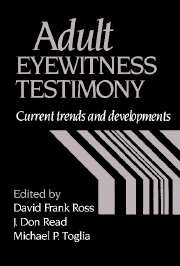Book contents
- Frontmatter
- Contents
- List of contributors
- Preface
- Part I Cognitive, physical and social processes and factors influencing eyewitness recall and identification
- Part II Lineup construction and collection of testimony
- 8 Conceptual, practical, and empirical issues associated with eyewitness identification test media
- 9 Biased lineups: Where do they come from?
- 10 Evaluating the fairness of lineups
- 11 Recommendations for properly conducted lineup identification tasks
- 12 Improving eyewitness testimony with the Cognitive Interview
- Part III Whom to believe? Distinguishing accurate from inaccurate eyewitnesses
- Name index
- Subject index
11 - Recommendations for properly conducted lineup identification tasks
Published online by Cambridge University Press: 04 August 2010
- Frontmatter
- Contents
- List of contributors
- Preface
- Part I Cognitive, physical and social processes and factors influencing eyewitness recall and identification
- Part II Lineup construction and collection of testimony
- 8 Conceptual, practical, and empirical issues associated with eyewitness identification test media
- 9 Biased lineups: Where do they come from?
- 10 Evaluating the fairness of lineups
- 11 Recommendations for properly conducted lineup identification tasks
- 12 Improving eyewitness testimony with the Cognitive Interview
- Part III Whom to believe? Distinguishing accurate from inaccurate eyewitnesses
- Name index
- Subject index
Summary
An eyewitness takes the stand and describes salient aspects of an event that he or she witnessed several months earlier. Then, in the hush of the courtroom, points to the defendant and says “That's him. That's the man I saw.” Simple, clean, and convincing. And therein rests the problem; what appears to be a simple identification is in fact the result of a series of complex and potentially unreliable social and cognitive events that began unfolding several months earlier when the event was originally witnessed.
This chapter, and much of the empirical research on which it is based, operates on an assumption that there are two sources of unreliability in eyewitness accounts. First, there are some inherent limitations in human information processing. These limitations exist at sensory levels (for example, Sperling, 1960), attentional levels (for example, Broadbent, 1958; Deutsch & Deutsch, 1963; Triesman, 1964), and memory levels (for example, Miller, 1956; Atkinson & Shiffrin, 1968). But inaccuracies in eyewitness accounts are not entirely attributable to human imperfections in sensation, perception, and memory. The second source of inaccuracy in eyewitness accounts can be attributed to the methods the justice system uses to obtain information from eyewitnesses. The work of Elizabeth Loftus on the effects of misleading questions serves to make this point (see Loftus, 1979; and this volume). The account one gets from an eyewitness depends very much on the methods used to solicit the information.
The study of how to improve eyewitness accuracy by manipulating the methods used to obtain information from eyewitnesses is known as a systemvariable approach to eyewitness research (Wells, 1978).
- Type
- Chapter
- Information
- Adult Eyewitness TestimonyCurrent Trends and Developments, pp. 223 - 244Publisher: Cambridge University PressPrint publication year: 1994
- 18
- Cited by



